
Maine Home Garden News – July 2021
In This Issue:
- July Is the Month to . . .
- Garden CSI – How to Think Like a Diagnostician
- UMaine Extension Debuts New Food and Nutrition Blog
- Farmer Donations of Seedlings on the Rise
- Cookbooks for Gardeners
- Black Swallow-wort, the Bane of the Garden
- Ornamental Pests
- Why Are My Cucurbits Wilting?
- Year of the Sunflower Article Update
July Is the Month to…
By Kate Garland, Horticulturist Penobscot County
- Make weeding more fun and efficient with a new tool. UMaine weed management researchers have produced a really nifty collection of short youtube videos showing how those interesting and sometimes odd-looking weeding tools really work. Check out their channel “Zero Seed Rain”.
- Add some excitement to your salads by stealing a bit from the crops growing in your field. Young leaves of carrots, peas, beets, radishes, onions, and basil are all fun flavors that will add a little flair to the traditional veggie side dish. Here are more examples of surprising secondary edible parts of vegetables.
- Mulch! It’s not too late to add a layer of mulch to your ornamental or edible beds. The options are endless and the approach depends on the types of plants you’re working with, the weeds you’re battling and the aesthetic you’re aiming for. At the Rogers Farm Demonstration Garden in Old Town, we’ve transitioned to mulching our ornamental beds with compost. It has the same dark appearance as the bark mulch we’ve used in the past, but is finer textured and will eventually break down faster so as not to accumulate as new mulch used to freshen up the look every year.
- Try your hand at propagating shrubs from softwood cuttings. Different species root well at different times of the year and some may require special conditions such as a rooting hormone or a particular type of growing media in order to successfully develop roots. Viburnum, elderberry, weigela, and forsythia are all examples of shrubs that root well from cuttings taken in early July. Collect cuttings from well-hydrated plants in the early morning, use a well-drained potting mix, such as a 50/50 mix of peat and perlite, and follow the instructions outlined in this helpful fact sheet. For those interested in diving deeper into propagating native plants, tap into the Native Plant Network Propagation Protocol Database for species-specific information.
- Make a trip to the farmers’ market part of your weekly routine or even a destination for a day trip. This is the perfect time to enjoy the freshest ingredients you’ll have all year and fall in love with a new vegetable or fruit. Maine farmers have so much to offer and are looking forward to seeing you at markets every day of the week and throughout the state.
- Remove spent flowers from annual plants and early blooming perennials. Not only will this practice result in a tidier look, but most flowering annuals will produce significantly more flowers with regular deadheading. Some perennials may even put on an encore performance, such as hardy geranium, dianthus, and Canada anemone.
Garden CSI – How to Think Like a Diagnostician
By Alicyn Smart, DPM Plant Pathologist & Director of the Plant Disease Diagnostic Laboratory
Anyone who slows down and looks at their plants often can think like a plant diagnostician and act like one. The more familiar you become with plants and how they look when they are healthy, the easier it becomes to determine when things are “off.” You become more likely to notice changes early if you start really paying attention to your plants — not just paying attention to them when you expect them to have produced a harvest. I will warn you, though, depending on how serious you take this charge, your driving skills might become impaired as you notice plant abnormalities and try to take a few seconds too long to get a better look — trust me.
Once you come across a symptom on the plant that shouldn’t be there, that’s when the real fun starts! It’s not merely identifying a chlorotic (yellow) leaf but considering all the possible reasons that leaf may have turned yellow. There are many reasons a leaf can turn chlorotic, so you are forced to view all the factors that might have resulted in the leaf being discolored. You start listing in your head all the possible reasons and then counterarguing them as if you are a diagnostician with a JD.
Could it have been from a lack of nitrogen? No, you did a soil test and applied the recommended amount for this crop. Are the roots compromised, making it so the roots can’t take up the nitrogen you know is in the soil? Pull one of the plants out of the soil and look at the roots. They are white and large and don’t seem to have any issues. As you come across problems and determine their cause, your list of possible causes grows, but you are faster to narrow the list.
Things to consider when listing possible causes are weather, where the symptom is on the plant (new growth, one side of the plant, etc.), the distribution of the plant (edge of planting, only in the low area, etc.), and if it is getting worse or staying the same. It’s also helpful to determine if only one crop has the symptom versus a wide host range showing similar symptoms.
There are many resources to help come to a diagnosis, but Google images are not one of them! They are often misidentified and can cause you to take the wrong management recommendations. Review our plant disease fact sheets for common diseases you might be seeing in your garden, Insect Pests, Ticks, and Plant Diseases.
If it’s still tough to pinpoint the culprit, we welcome you to reach out to your local Extension office via email. Here’s a great video outlining how to capture useful images for the diagnostic process.
https://youtu.be/0wYH0cSJhZY
UMaine Extension Debuts New Food and Nutrition Blog
University of Maine Cooperative Extension is offering a new blog that shares timely, research-based food and nutrition content in an easy-to-digest format. “Spoonful: Bite-Sized Food & Nutrition Information” is updated once to twice a week, with posts about new recipes, food preservation, and food safety, grocery shopping on a budget, health tips, and more.
UMaine Extension also offers online nutrition education for adults, food preservation webinars, pressure canner dial gauge testing, and food safety training for volunteer cooks. Information about these programs and more can be found on the Extension Food & Health website.
Subscribe to the blog to receive monthly email updates. For more information or to request a reasonable accommodation, contact Kate McCarty, 207.781.6099; kate.mccarty@maine.edu.

Farmer Donations of Seedlings on the Rise
By Lynne Holland, Community Education Assistant, Androscoggin & Sagadahoc Counties
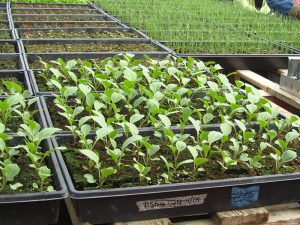 Many years ago a man who sold seeds for a living told me, “Every packet of seeds is a packet of dreams, that’s why there are so many seeds in each packet.” If you have ever started seeds you know you will either have too many or not enough when all those dreams germinate. You will also know how hard it is to throw a seedling out into the compost pile.
Many years ago a man who sold seeds for a living told me, “Every packet of seeds is a packet of dreams, that’s why there are so many seeds in each packet.” If you have ever started seeds you know you will either have too many or not enough when all those dreams germinate. You will also know how hard it is to throw a seedling out into the compost pile.
When a farmer starts seeds it is generally to create seedlings for the farm, or the farmstand, or for both. By the middle of June the market for seedlings has dried up and most folks are looking for the early season radishes, lettuce, turnip, and other June harvested food. The farmers in Maine began a trend last year as the pandemic peaked and a scarcity of seeds meant many new gardeners had nothing to plant. Through several gleaning groups, the farmers who would later have gleaners gather produce through the Harvest for Hunger Program called those gleaners and asked if they could “glean” some seedlings. As Scott Roberts, Master Gardener Volunteer and Androscoggin Gleaner said, “Nothing says we have to glean just produce; why not share seedlings at the pantries and meal sites we serve.”
In 2021 the trend to donate seedlings is on the rise. Pamela Hargest, Horticulture Professional in Cumberland County, noted, “Seedling donations are on the rise in Cumberland County too. I think this is such a unique part of the Maine Harvest for Hunger program and it is beneficial for farmers to have somewhere to donate seedlings.” Just up the coast, the Merrymeeting Gleaners feel their donations of seedlings may nearly double this year based on the calls they are getting from their regular farmers just this week. Kelly Davis, Master Gardener Volunteer, and coordinator for this gleaning group notes, “These farmers could choose not to donate for fear of losing business. But instead, they donate because they know that the plants will go to those who need them.”
“There is so much potential in this grassroots program, a typical tomato plant can yield 8 or 10 pounds of tomatoes later in the season,” noted Davis about the growth in this phenomenon. It is likely the availability of these “extras” will settle down in the coming years as the demand for seedlings becomes a little more predictable, but even a few hundred seedlings can make a difference. This week, literally thousands of small plants, all the usual garden suspects, will be showing up in food pantry offerings, community, and school gardens, as well as on sharing tables, due to generous Maine farmers. So from packets of dreams to flats of food, those seeds have become small plants and are now headed to families, gardens, and projects to feed our neighbors in need.
Cookbooks for Gardeners
By Barbara Harrity, Master Gardener Volunteer in Penobscot County
These days, with a limitless world of recipes available through my tablet, I sometimes wonder why I still love cookbooks. I love browsing libraries’ cookbook collections or reading reviews, and when a cookbook really stands out, either through the content it covers or the beauty of the recipes, I buy a copy to add to my collection. After thinking over this question, I’ve decided my appreciation for printed cookbooks comes down to these factors: Cookbooks offer a curated collection of recipes written by an expert; the recipes have been tested and copyedited so they’re easy to replicate; favorites recipes are easy to find again, and cookbooks have a historical value since they reflect the foods and styles of cooking that people were interested in at the time the books were published. With that in mind, here are some recently published cookbooks that might appeal to gardeners.
Six Seasons: A New Way with Vegetables by Joshua McFadden with Martha Holmberg, published in 2017 by Artisan.
Author Joshua McFadden, the owner of Ava Gene’s restaurant in Portland, Oregon, is both a chef and a gardener (he worked on Four Season Farm in Harborside, Maine, in the late 2000s). His cross-training shows in this beautiful and inspiring cookbook. The recipes are arranged according to six seasons — spring, early summer, mid-summer, late summer, fall, and winter — and seem inspirational (aspirational), but not daunting. Recipes are accompanied by colorful photographs and illustrations, and unlike many hardcover cookbooks, the spine is designed so the book lies flat when opened to any page.
The Cook’s Herb Garden by Jeff Cox (gardener) and Marie Pierre Moine (cook), published in 2010 by DK Publishing.
The Cook’s Herb Garden is a small book that helps readers choose herbs they want to grow, then provides detailed information on how to grow, harvest, and store them. Full-color photographs throughout spark ideas for container growing based on culinary uses (for example, Mediterranean herbs, or herbs for teas) and show harvesting methods and creative ways to save herbs for later use. The book ends with a smattering of recipes and useful “partner charts” showing which herbs go well with which ingredients.
Essential Vegetable Fermentation by Kelly McVicker, published in 2020 by Rockridge Press.
Essential Vegetable Fermentation is a simple, unfussy book that outlines the fermentation process and then provides 70 recipes to get one started fermenting at home. The explanations of the process and the simplest recipes are perfect for beginners, and the abundance of interesting recipes will inspire experienced fermenters to try new taste combinations.
Black Swallow-wort, the Bane of the Garden
By Lynne Holland, Community Education Assistant, Androscoggin & Sagadahoc Counties
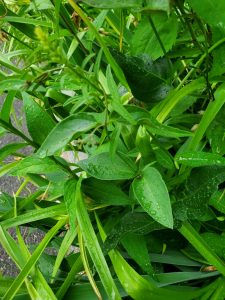 Fool me once, shame on me; fool me twice and this plant is everywhere. It was in October, a few years ago when we moved into a new “old” house. It had a lovely rock wall on one side of the property and an established, professionally maintained garden next to that wall. On moving day, the wall was a vivid mix of old weathered stones partially covered with a dark green vine with light green pods weaving through the red wild grape leaves like a river of summer. I could not wait to dig into that border planting in the spring and make sure that vine was uniformly spread along that 75-foot wall. The next spring I went to work transplanting that vine and waiting to see what flowers produced those green pods. The dark purple, almost black star-shaped flowers were small but plentiful. By later that summer I began to think that maybe I had too much of a good thing. By August, I was doing research and then cursing myself for spreading dreaded swallow-wort throughout my entire perennial border.
Fool me once, shame on me; fool me twice and this plant is everywhere. It was in October, a few years ago when we moved into a new “old” house. It had a lovely rock wall on one side of the property and an established, professionally maintained garden next to that wall. On moving day, the wall was a vivid mix of old weathered stones partially covered with a dark green vine with light green pods weaving through the red wild grape leaves like a river of summer. I could not wait to dig into that border planting in the spring and make sure that vine was uniformly spread along that 75-foot wall. The next spring I went to work transplanting that vine and waiting to see what flowers produced those green pods. The dark purple, almost black star-shaped flowers were small but plentiful. By later that summer I began to think that maybe I had too much of a good thing. By August, I was doing research and then cursing myself for spreading dreaded swallow-wort throughout my entire perennial border.
When a plant’s common name has “wort” in it, it is actually old English for plant and generally refers to either the medicinal value of the plant or the shape of the leaves of that plant. Lungwort has leaves shaped like lungs and it was believed that it would help with asthma and chest diseases. Once I realized I was dealing with Swallow-wort I began to also understand its other common names Dog’s Bane or Dog Stangle Vine, as well as its ability to swallow all the plants around it.
The state of Minnesota has a comprehensive fact sheet on Swallow-wort (Cynanchum louiseae or Vincetoxim nigrum) that outlines the history of this plant in America. It is believed that it was brought in as an ornamental plant in the 19th century and soon escaped. The University of Wisconsin has a short video showing how to identify the plant.
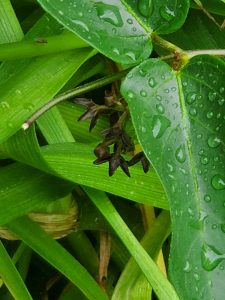 As part of the milkweed family, it would be easy to assume that this profusely flowering plant, though irritating to the home gardener or farmer, would be a help to pollinators. You would be wrong. The problem is that this invasive species not only pushes out other native plants by strangulation, it is also a close relative to common milkweed so it entices monarch butterflies to lay their eggs on it. Angela Gupta, Extension Educator in forestry and natural resources for the University of Minnesota, has been warning of the danger to monarch butterflies that swallow-wort brings. “It’s in the milkweed family, so monarchs will lay their eggs on it,” she says. “However, when the larvae emerge they can’t survive on black swallow-wort and so they die.” In addition, insect predators avoid swallow-wort as they have toxic properties as well as a bad taste. In fact, it can even be toxic to livestock and deer.
As part of the milkweed family, it would be easy to assume that this profusely flowering plant, though irritating to the home gardener or farmer, would be a help to pollinators. You would be wrong. The problem is that this invasive species not only pushes out other native plants by strangulation, it is also a close relative to common milkweed so it entices monarch butterflies to lay their eggs on it. Angela Gupta, Extension Educator in forestry and natural resources for the University of Minnesota, has been warning of the danger to monarch butterflies that swallow-wort brings. “It’s in the milkweed family, so monarchs will lay their eggs on it,” she says. “However, when the larvae emerge they can’t survive on black swallow-wort and so they die.” In addition, insect predators avoid swallow-wort as they have toxic properties as well as a bad taste. In fact, it can even be toxic to livestock and deer.
There is no shortage of bulletins, fact sheets, and warnings about the invasiveness of this plant. Once it is in your garden it will be an ongoing battle. There are several ways to deal with this plant depending on the size of the problem and the fragility of the area it has invaded. One thing is certain, it will take a while to get rid of it completely. Realistically, it is more likely a plant to be managed rather than completely eradicated. The Cornell fact sheet on this topic is probably the most comprehensive.
I was not new to gardening that day in October. In fact, I had owned and gardened in many places and at least four USDA zones by that point. So learn from my tale so you are not doomed to repeat it and have your garden swallowed by the dreaded swallow-wort.
Resources:
- Bulletin #2523, Maine Invasive Plants: Black Swallowwort, Cynanchum louiseae (Milkweed Family)
- Lungwort
- Cornell Fact Sheet, Swallow-Worts
- Black Swallow-wort
- Invasive in the Spotlight: Swallow-wort
- Report and remove black swallow-wort plant to help monarch butterflies
- Black and pale swallow-worts: These milkweed family members are toxic to monarchs
Ornamental Pests
By Renée DesRoberts, York County Master Gardener Volunteer; Photo credits to Renée DesRoberts
This month I have found lots of little critters chowing down on my ornamentals, so I thought it would be fun to spotlight 3 and hopefully help you ID some pests that we all probably see in our yards – and more importantly whether or not they are worth worrying about! Interestingly enough, it seems all the insects on my list turned out to be beetles (ergo the bad Coleoptera joke in the title).

First, let’s talk about Rose chafer (Macrodactylus subspinosus) who I thought at first was a potato bug. These pests are leaf-feeding scarab beetles, like the dreaded Japanese beetles – but unlike Popillia japonica, the Chafers can be less damaging – or at least feed for a much shorter period. I have found they are really attracted to my Arrowwood viburnum, but they are also problems for roses, peonies, and others. They are very easy to pick off – drop them in your trusty bucket of (biodegradable) soapy water if you wish to avoid chemical treatments. Another interesting suggestion is to plant “lure” plants that develop before the plants you wish to protect, thus drawing the bulk of your pest problem away from your extra special plants.
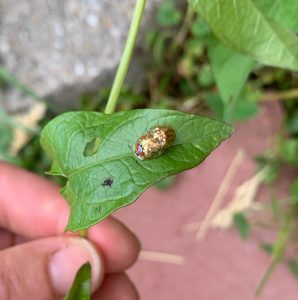
The second is the beautiful Golden Tortoise Beetle (Charidotella sexpunctata). These striking little leaf beetles are seen on morning glories and field bindweed, but you’ll see them on sweet potatoes too if you have those growing. The damage caused by these insects is superficial rather than deadly, so they are one you could probably forget about and focus on serious pests.
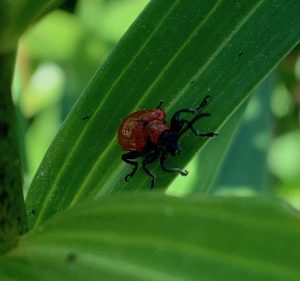
The final, and worst, of the bunch, is the invasive Red Lily Leaf Beetle (Lilioceris lilii), which are Northeastern-specific pests that will extensively defoliate your true lilies. They will also eat a variety of other garden mainstays (Hostas, Solomon’s Seal, etc.) but they only spend their true lilies and fritillaries. They are a newer (1992) invasive from Europe with no natural predators here yet, but an early morning recon with your soapy water bucket is again effective control if you wish to avoid chemical treatments.
It’s a nice reminder that while not every insect is beneficial, neither are they all a real “pest” that you have to treat or worry about. I like Cranshaw and Shetlar’s “Garden Insects of North America, 2nd ed.”, Maine.gov’s own Got Pests website, and UMaine Extension’s Home and Garden IPM website as three great tools to help you get to know the good, the bad, and the meh insects in your own yard and garden!
Further reading:
- Lily Leaf Beetle
- Rose Chafer
- Tortoise Beetles
- Garden Insects of North America, 2nd ed. By Whitney Cranshaw and David Shetlar. Princeton University Press, 2018.
Why Are My Cucurbits Wilting?
Adapted from an article by Beth K. Gugino, Professor Vegetable Pathology, Penn State
There are a number of diseases like bacterial wilt, cucurbit yellow vine decline, and Fusarium wilt as well as abiotic stresses such as waterlogged soils that can cause cucurbits to wilt.
Below is a description of a few diseases that can lead to wilting. In all these cases, the wilting is a result of the pathogen or pest compromising the vascular system and preventing the plant from moving water and nutrients from the roots to the shoots. Although there is not much that can be done once you see symptoms in the field, it is important to determine the cause to inform your management decisions for the next growing season whether it changes in your crop rotation, selection of resistant varieties, etc.
Fusarium Wilt
Fusarium wilt most commonly affects watermelon, muskmelon, and cucumber. The fungal pathogen Fusarium oxysporum is very host-specific so watermelon, muskmelon, and cucumber are all susceptible to their own unique strain of the pathogen. On more mature plants, the leaves will initially become a dull green to gray-green, and the older leaves more yellow. The shoot tips will wilt and then become brown and dried up with individual vines on the plant collapsing and eventually the entire plant collapsing. Symptoms are most severe when the plants are stressed or during fruiting. One diagnostic characteristic is the light to dark brown discoloration of the xylem tissue in the crown and lower portion of the stem. This pathogen can persist in the soil for many years as chlamydospores. Since Fusarium is a true soilborne pathogen, the symptoms will tend to develop in hot spots in the field which will slowly expand over time with each susceptible crop and as tillage and field preparation practices move soil within the field.
Verticillium Wilt
Verticillium wilt, which is most problematic on cucumber and pumpkin, has a very wide host range including over 400 different hosts. Symptoms typically develop during fruit set with the lower leaves initially becoming off green and wilting of the lower leaves. These leaves eventually become necrotic and dry up. With Verticillium wilt, the symptoms are often observed on only one side of the plant. As with Fusarium wilt, the xylem tissue will become tan to brown in color. The pathogen can survive in the soil for many years, sometimes as long as 8 to 10 years, as microsclerotia are the size of poppy seeds.
Bacterial Wilt
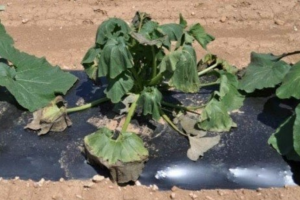
Bacterial wilt is caused by the bacterial pathogen Erwinia tracheiphila which is vectored by the cucumber beetle. It is most damaging on cucumber and muskmelon, less so on pumpkin and squash, and not a considered problem on watermelon. Symptoms initially include individual leaves that become off-green in color and wilt before turning necrotic brown and drying up. Eventually, entire vines can collapse. Cucumber beetles feeding on individual leaves can result in water-soaked pale green and then necrotic lesions on the leaves. Sticky strands of bacterial ooze can sometimes be observed when the cut ends of a cucurbit stem are pulled apart, however, an absence of the sticky ooze does not mean an absence of disease. The sticky ooze can vary depending on the environment and cucurbit host. The key to managing bacterial wilt is managing the cucumber beetle early in the season. Individual symptomatic plants are often scattered across the field rather than occurring in hotspots like some of the other wilt diseases due to the distribution of the cucumber beetle and the fact that not all cucumber beetles contain the bacterial pathogen.
Squash Bug Feeding
Squash bugs themselves can also cause direct damage by using the piercing-sucking mouthparts to suck the sap out of the leaves causing them to wilt and collapse. Intense feeding can cause the entire leaf to collapse. Although the squash bug is considered a pest on all cucurbits, it prefers squash and pumpkins.
Year of the Sunflower Article Update
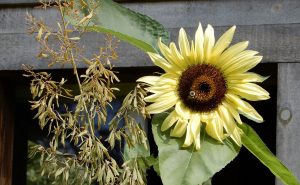 We recently shared an article from the National Garden Bureau about 2021 being the year of the sunflower. While the article did a great job covering many cultivated varieties, we missed the opportunity to highlight some terrific native sunflower species.
We recently shared an article from the National Garden Bureau about 2021 being the year of the sunflower. While the article did a great job covering many cultivated varieties, we missed the opportunity to highlight some terrific native sunflower species.
Including native plants in our landscapes is a key step in supporting biodiversity. Learn more on Maine Audubon’s “Bringing Nature Home” page. Many thanks go to the reader who suggested that we include this information. We always appreciate reader feedback.
Do you appreciate the work we are doing?
Consider making a contribution to the Maine Master Gardener Development Fund. Your dollars will support and expand Master Gardener Volunteer community outreach across Maine.
Your feedback is important to us!
We appreciate your feedback and ideas for future Maine Home Garden News topics. We look forward to sharing new information and inspiration in 2020.
Subscribe to Maine Home Garden News
Let us know if you would like to be notified when new issues are posted. To receive e-mail notifications, click on the Subscribe button below.
University of Maine Cooperative Extension’s Maine Home Garden News is designed to equip home gardeners with practical, timely information.
For more information or questions, contact Kate Garland at katherine.garland@maine.edu or 1.800.287.1485 (in Maine).
Visit our Archives to see past issues.
Maine Home Garden News was created in response to a continued increase in requests for information on gardening and includes timely and seasonal tips, as well as research-based articles on all aspects of gardening. Articles are written by UMaine Extension specialists, educators, and horticulture professionals, as well as Master Gardener Volunteers from around Maine, with Katherine Garland, UMaine Extension Horticulturalist in Penobscot County, serving as editor. Special thanks to our 2020 Master Gardener Volunteer co-editors Naomi Jacobs and Abby Zelz.
Information in this publication is provided purely for educational purposes. No responsibility is assumed for any problems associated with the use of products or services mentioned. No endorsement of products or companies is intended, nor is criticism of unnamed products or companies implied.
© 2021
Call 800.287.0274 (in Maine), or 207.581.3188, for information on publications and program offerings from University of Maine Cooperative Extension, or visit extension.umaine.edu.
The University of Maine is an EEO/AA employer, and does not discriminate on the grounds of race, color, religion, sex, sexual orientation, transgender status, gender expression, national origin, citizenship status, age, disability, genetic information or veteran’s status in employment, education, and all other programs and activities. The following person has been designated to handle inquiries regarding non-discrimination policies: Director of Equal Opportunity, 101 North Stevens Hall, University of Maine, Orono, ME 04469-5754, 207.581.1226, TTY 711 (Maine Relay System).
